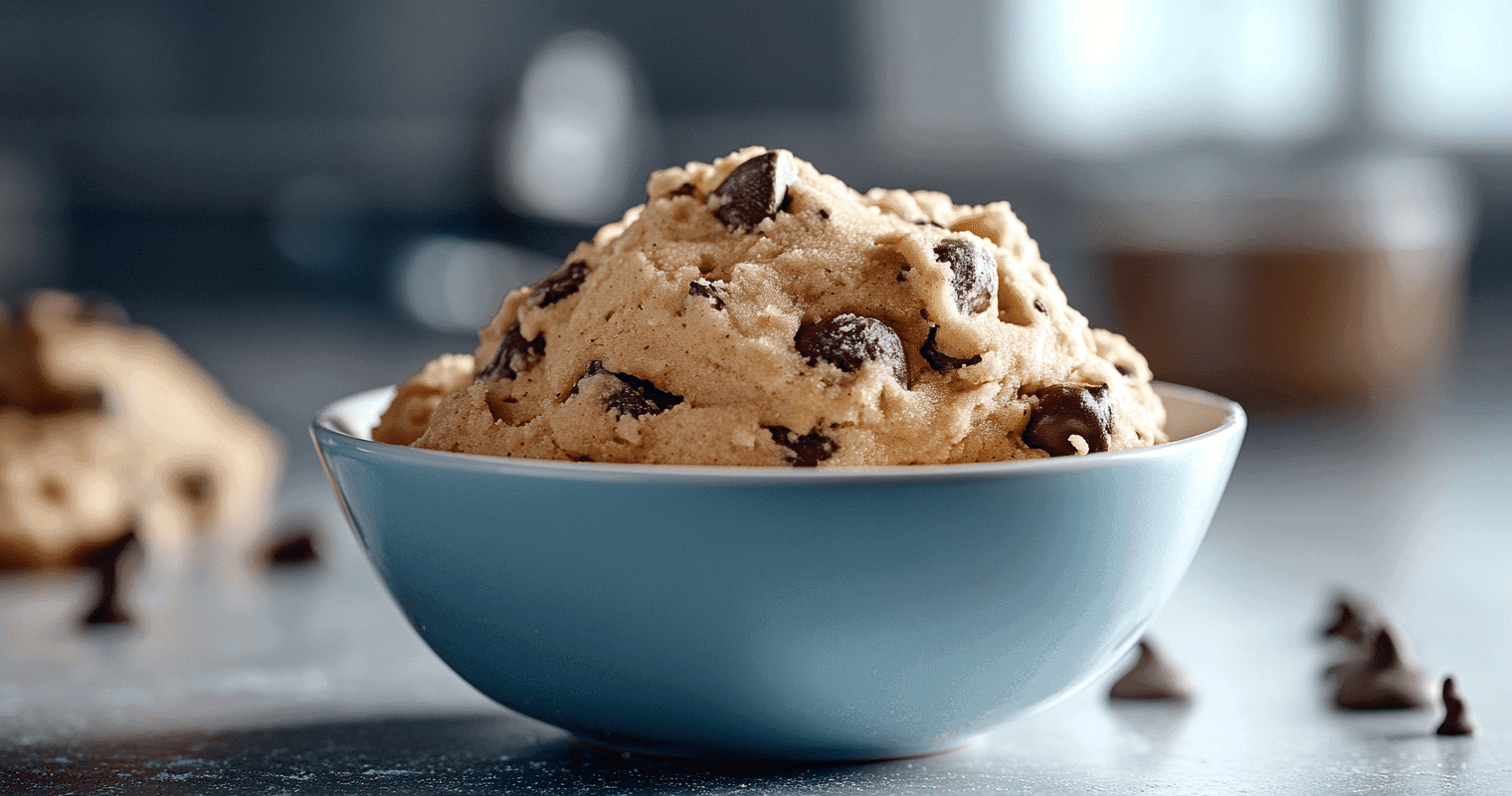Jump to:
Estimated reading time: 11 minutes
Table of contents
Introduction
Edible cookie dough has become a popular treat, offering the delicious taste of cookie dough without the risks associated with raw ingredients. However, making cookie dough safe to eat requires some precautions, particularly when it comes to raw flour. While most people know to avoid raw eggs, many are unaware that flour can also harbor harmful bacteria. This raises the question: Can you microwave flour for edible cookie dough? The answer is yes, and in this article, we’ll explore how to safely microwave flour, why it’s necessary, and tips for creating the perfect batch of edible cookie dough.
Why Heat-Treating Flour is Essential
Before diving into the process of microwaving flour, it’s important to understand why this step is necessary for making edible cookie dough. Flour is a raw agricultural product, and as such, it can be contaminated with harmful bacteria like E. coli. These bacteria are typically killed during baking, but when making edible cookie dough, the flour remains uncooked, posing a potential health risk.
The Risks of Raw Flour
Raw flour can contain bacteria that cause foodborne illnesses. E. coli outbreaks linked to flour have led to recalls and warnings, emphasizing the need to heat-treat flour before using it in no-bake recipes. By microwaving the flour, you effectively kill any harmful bacteria, making it safe to use in edible cookie dough.
Alternatives to Microwaving
While microwaving is a quick and convenient method to make flour safe for consumption, it’s not the only option. Other methods include baking the flour in the oven or using commercially available heat-treated flour. However, microwaving is often preferred for its speed and ease, especially when you’re craving cookie dough and don’t want to wait.
Alternative Methods of Heat-Treating Flour
Understanding the importance of heat-treating flour sets the stage for why and how to microwave flour for cookies. Next, we’ll delve into the step-by-step process to ensure your flour is safe and ready for your favorite edible cookie dough recipes.
How to Microwave Flour for Edible Cookie Dough
Now that we’ve established the importance of heat-treating flour, let’s walk through the steps to microwave flour for cookies. This method is straightforward, quick, and ensures that your flour is safe to use in edible cookie dough.
Step 1: Measure the Flour
Begin by measuring the amount of flour you’ll need for your cookie dough recipe. It’s a good idea to prepare a little extra, as some of the flour may clump during microwaving and may need to be sifted before use.
Step 2: Spread the Flour Evenly
Spread the measured flour evenly on a microwave-safe plate or shallow dish. Spreading the flour ensures even heating, which is crucial for killing any bacteria that may be present.
Step 3: Microwave in Intervals
Microwave the flour on high for 30-second intervals. After each interval, stir the flour with a spoon or fork to break up any hot spots and promote even heating. Continue microwaving and stirring the flour until it reaches a temperature of 165°F (74°C). This is the temperature at which harmful bacteria are effectively killed.
Pro Tip: Use a food thermometer to check the temperature of the flour after each interval. This ensures that you reach the safe temperature without overheating the flour, which can affect its texture.
Step 4: Cool the Flour
Once the flour has been heated to the appropriate temperature, remove it from the microwave and allow it to cool completely. Cooling the flour is important because adding hot flour directly to your dough can affect the consistency and may cause the butter to melt.
Step 5: Sift the Flour
After the flour has cooled, sift it through a fine-mesh sieve to remove any clumps that may have formed during microwaving. Sifting also helps to aerate the flour, making it easier to incorporate into your cookie dough.
Step 6: Use in Your Recipe
Your flour is now safe and ready to be used in your edible cookie dough recipe. Simply follow your recipe as usual, substituting the heat-treated flour for raw flour.
By following these steps, you can microwave flour for cookies and ensure that your edible cookie dough is both safe and delicious. Next, we’ll explore some tips and variations to help you get the best results every time.
Tips for Microwaving Flour Successfully
Microwaving flour may seem straightforward, but there are a few tips and tricks that can help you achieve the best results. Whether you’re a seasoned baker or new to making edible cookie dough, these insights will help you microwave flour for cookies effectively.
Tip 1: Stir Frequently
Stirring the flour frequently during microwaving is essential for even heating. This helps to prevent hot spots and ensures that all parts of the flour reach the necessary temperature to kill bacteria.
Tip 2: Avoid Overheating
While it’s important to reach the safe temperature of 165°F (74°C), overheating the flour can cause it to dry out or develop an unpleasant taste. To avoid this, use short intervals and check the temperature frequently.
Tip 3: Use a Food Thermometer
A food thermometer is a valuable tool when you microwave flour for cookies. It allows you to accurately monitor the temperature of the flour, ensuring that it’s safe to use without overheating.
Tip 4: Sift After Microwaving
Sifting the flour after microwaving helps to remove any clumps and ensures a smooth, even texture in your cookie dough. It also helps to aerate the flour, making it easier to incorporate into your recipe.
Tip 5: Microwave in Small Batches
If you’re making a large batch of cookie dough, it’s best to microwave the flour in small batches. This ensures even heating and reduces the risk of overheating the flour.
Tip 6: Store Heat-Treated Flour Properly
If you’ve microwaved more flour than you need, store the extra in an airtight container at room temperature. Heat-treated flour can be stored for future use, making it easy to whip up a batch of edible cookie dough whenever the craving strikes.
By following these tips, you can microwave flour for cookies with confidence, knowing that your flour is safe and ready for use. Next, we’ll discuss some common mistakes to avoid when microwaving flour, helping you to achieve the best possible results.
Common Mistakes When Microwaving Flour
Even with the best intentions, it’s easy to make mistakes when you microwave flour for cookies. Understanding these common pitfalls can help you avoid them and ensure that your flour is properly heat-treated.
Mistake 1: Microwaving Too Much Flour at Once
One of the most common mistakes is microwaving too much flour at once. When the flour is piled too thickly on the plate, it can be difficult to ensure even heating. This can result in some areas not reaching the safe temperature, leaving the flour potentially unsafe to use.
Mistake 2: Not Stirring the Flour
Failing to stir the flour during microwaving can lead to uneven heating. Hot spots can develop, causing some parts of the flour to overheat while others remain undercooked. To avoid this, always stir the flour after each interval.
Mistake 3: Overheating the Flour
Overheating the flour can cause it to dry out, become clumpy, or develop a burnt taste. To prevent this, use short intervals and monitor the temperature closely. Remember that the goal is to reach 165°F (74°C) without going too far beyond that point.
Mistake 4: Using a Non-Microwave-Safe Dish
Using a dish that isn’t microwave-safe can lead to uneven heating or even damage to your microwave. Always use a microwave-safe plate or shallow dish when microwaving flour.
Guide to Microwave-Safe Dishes
Mistake 5: Skipping the Cooling Step
Skipping the cooling step can lead to issues when you incorporate the flour into your cookie dough. Hot flour can cause the butter to melt, resulting in dough that is too soft and difficult to handle. Always allow the flour to cool completely before using it in your recipe.
Mistake 6: Not Sifting the Flour
Sifting the flour after microwaving helps to remove clumps and ensures a smooth texture in your cookie dough. Skipping this step can result in uneven dough and pockets of dry flour in your cookies.
By avoiding these common mistakes, you can microwave flour for cookies more effectively, ensuring that your flour is safe and ready for use in edible cookie dough. Next, we’ll explore some alternative methods for heat-treating flour if you prefer not to use a microwave.
Alternative Methods to Heat-Treat Flour
While microwaving is a quick and convenient way to heat-treat flour, there are alternative methods that you can use if you prefer. These methods may take a little longer, but they are just as effective at making flour safe for use in edible cookie dough.
Oven Method
The oven method is a popular alternative to microwaving and is ideal if you need to heat-treat a large batch of flour.
How to Do It: Preheat your oven to 350°F (175°C). Spread the flour evenly on a baking sheet lined with parchment paper. Bake the flour for 5-10 minutes, stirring halfway through to ensure even heating. Use a food thermometer to check that the flour has reached 165°F (74°C). Once done, remove the flour from the oven and allow it to cool completely before using.
Pro Tip: The oven method is great for large batches, but be sure to monitor the flour closely to prevent it from browning or developing an off taste.
Stovetop Method
The stovetop method is another alternative, although it requires more attention to avoid burning the flour.
How to Do It: Place the flour in a large, dry skillet over medium heat. Stir the flour constantly as it heats, ensuring even cooking. Continue stirring and heating until the flour reaches 165°F (74°C). Once done, transfer the flour to a plate or bowl to cool completely.
Pro Tip: The stovetop method is best for small batches of flour, as it can be difficult to maintain even heating in larger quantities.
Commercial Heat-Treated Flour
If you prefer not to heat-treat flour at home, you can purchase commercially available heat-treated flour. This flour has been treated to eliminate bacteria, making it safe to use in edible cookie dough without the need for additional heat treatment.
How to Use It: Simply substitute commercially heat-treated flour for regular flour in your edible cookie dough recipes. This option is convenient and ensures that your dough is safe to eat without any extra steps.
Pro Tip: Look for heat-treated flour at specialty baking stores or online retailers. It’s a great option for those who frequently make no-bake treats.
Each of these alternative methods offers a reliable way to make flour safe for use in edible cookie dough. Whether you prefer to microwave flour for cookies or use another method, the key is to ensure that the flour reaches the necessary temperature to kill harmful bacteria.
Frequently Asked Questions About Microwaving Flour for Cookies
Even with detailed instructions, it’s natural to have questions about how to microwave flour for cookies. Here are some common questions and answers to help you navigate the process.
How long should I microwave flour to make it safe?
The time needed to microwave flour for cookies varies depending on the power of your microwave and the amount of flour you’re heating. Generally, it takes 1-2 minutes, in 30-second intervals, to reach the safe temperature of 165°F (74°C). Be sure to stir the flour after each interval to ensure even heating.
Can I microwave flour without stirring it?
It’s not recommended to microwave flour without stirring, as this can lead to uneven heating. Some parts of the flour may overheat while others remain undercooked, leaving it unsafe to use. Always stir the flour after each microwaving interval to ensure it heats evenly.
Is microwaving flour safe for all types of recipes?
Microwaving flour is safe for recipes that don’t involve further baking or cooking, such as edible cookie dough or no-bake desserts. For baked goods that will go into the oven, there’s no need to preheat the flour, as the baking process will eliminate any harmful bacteria.
Can I store heat-treated flour for future use?
Yes, you can store heat-treated flour in an airtight container at room temperature. This makes it convenient to have on hand for future batches of edible cookie dough. Just be sure to label the container so you know it’s already been heat-treated.
Conclusion: Microwave Flour for Cookies
Making edible cookie dough at home is a fun and satisfying way to enjoy the taste of raw cookie dough without the risks associated with raw ingredients. By learning how to microwave flour for cookies, you can ensure that your flour is safe to use, allowing you to indulge in this sweet treat worry-free, if you need insightful guides on how to make a perfect dough, check this one here or this one.
The process of microwaving flour is simple and effective, requiring just a few minutes and some basic kitchen tools. Whether you’re whipping up a quick batch of cookie dough for yourself or preparing a large batch for a party, heat-treating the flour is an essential step in making your dough safe to eat.
In addition to microwaving, there are other methods to heat-treat flour, such as using the oven or stovetop. Each method has its advantages, so you can choose the one that best fits your needs and kitchen setup.
By following the tips and guidelines provided in this article, you can confidently microwave flour for cookies and create delicious, safe-to-eat cookie dough every time. So go ahead, grab your ingredients, and enjoy the sweet, doughy goodness of homemade edible cookie dough, knowing that you’ve taken the necessary steps to make it safe. Happy baking!






